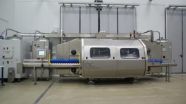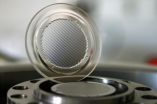New Year's Eve tip from American Chemical Society journal: Pour champagne down the side of the glass
2010-12-23
(Press-News.org) WASHINGTON, Dec. 22, 2010 — Just in time for New Year's Eve, and the arrival of the International Year of Chemistry, a study may settle that long-standing disagreement over the best way to pour a glass of champagne: Scientists in France are reporting that pouring bubbly in an angled, down-the-side way is best for preserving its taste and fizz.
The study also reports the first scientific evidence confirming the importance of chilling champagne before serving to enhance its taste. They reported in the American Chemical Society's Journal of Agricultural and Food Chemistry.
Gérard Liger-Belair and colleagues note that tiny bubbles are the essence of fine champagnes and sparkling wines. Past studies indicate that the bubbles — formed during the release of large amounts of dissolved carbon dioxide gas — help transfer the taste, aroma, and mouth-feel of champagne. Scientists long have suspected that the act of pouring a glass of bubbly could have a big impact on gas levels in champagne and its quality. Until now, however, no scientific study had been done.
The scientists studied carbon dioxide loss in champagne using two different pouring methods. One involved pouring champagne straight down the middle of a glass. The other involved pouring champagne down the side of an angled glass.
They found that pouring champagne down the side preserved up to twice as much carbon dioxide in champagne than pouring down the middle — probably because the angled method was gentler. They also showed that cooler champagne temperatures (ideally, 39 degrees Fahrenheit) help reduce carbon dioxide loss.
INFORMATION:
The American Chemical Society is a nonprofit organization chartered by the U.S. Congress. With more than 161,000 members, ACS is the world's largest scientific society and a global leader in providing access to chemistry-related research through its multiple databases, peer-reviewed journals and scientific conferences. Its main offices are in Washington, D.C., and Columbus, Ohio.
END
ELSE PRESS RELEASES FROM THIS DATE:
2010-12-23
The AZTI-Tecnalia technological centre, in a project undertaken by the Tecnolat and Llet de Catalunya dairy product companies within the FUTURAL project, has verified that, as an alternative to the traditional heat treatment for decontamination of a number of dairy products, high pressure technology is highly recommendable. In fact, according to a press release from Tecnolat, the results, especially with ready-to-eat fruit products and in the inactivation of moulds and yeasts in other dairy products, "were highly positive and promising".
The research and trials carried ...
2010-12-23
FINDINGS: By determining how corticosteroids act to increase production of red blood cell progenitors, Whitehead Institute researchers have identified a class of drugs that may be beneficial in treating some erythropoietin-resistant anemias. One such anemia is Diamond-Blackfan anemia (DBA), which is frequently treated with corticosteroids, despite their severe side-effects. The identified class of drugs may be able to treat other anemias, including those resulting from trauma, sepsis, malaria, kidney dialysis, and chemotherapy.
RELEVANCE: Some common anemias can be treated ...
2010-12-23
Researchers at Cleveland Clinic's Genomic Medicine Institute have revealed multiple genetic discoveries that may permit easier diagnosis and disease management for Cowden syndrome patients who are predisposed to breast and kidney cancer.
The research, which could allow for earlier discovery of cancerous tumors, is published in the Dec. 22 issue of the Journal of the American Medical Association (JAMA).
Charis Eng, M.D., Ph.D, Chair of the Genomic Medicine Institute at Cleveland Clinic, led the research. It revealed KILLIN as a novel predisposition gene for Cowden ...
2010-12-23
December 21, 2010 — (BRONX, NY) — Two researchers at Albert Einstein College of Medicine of Yeshiva University have found that our 98.6° F (37° C) body temperature strikes a perfect balance: warm enough to ward off fungal infection but not so hot that we need to eat nonstop to maintain our metabolism.
"One of the mysteries about humans and other advanced mammals has been why they are so hot compared with other animals," said study co—author Arturo Casadevall, M.D., Ph.D., professor and chair of microbiology & immunology at Einstein. "This study helps to explain why mammalian ...
2010-12-23
Projectors are getting smaller and smaller. Now that pictures are available in digital format almost everywhere, we need projectors to beam giant photos and films onto walls. Projectors contain lenses that spread the light from the pixelated source in such a way as to illuminate the image area evenly. Until now, this was done using complicated arrays of lenses placed one behind the other. Recently, the same effect has been achieved using flat lens arrays made up of thousands of identical microlenses. This kind of array takes up much less space and does not need to be painstakingly ...
2010-12-23
The only way to learn if your water source has hexavalent chromium is to check with your public water supplier and request a water quality report, said NJIT Professor Taha Marhaba, a civil/environmental engineer. Most municipal or city engineers should be able to provide such a report upon request. Additional information specifically about hexavalent chromium levels may also be available.
"In general, hexavalent chromium can be found in either surface or groundwater sources and its source can be either natural or man-made industrial operations that have used chromium," ...
2010-12-23
About 50 miles from Bethlehem, a drilling project is determining the climate and earthquake activity of the Holy Land. Scientists from eight nations are examining the ground below the Dead Sea, by placing a borehole in this deepest basin in the world. The International Continental Scientific Drilling Program ICDP brings together research teams from Israel, Japan, Norway, Switzerland, the USA and Germany. Particularly noteworthy: Researchers from Jordan and Palestine are also involved.
Scientists and technicians of the GFZ German Research Centre for Geosciences have now ...
2010-12-23
JACKSONVILLE, Fla. — Neuroscientists had assumed that a mutation in the progranulin gene, which makes the progranulin protein and supports brain neurons, was sufficient to produce a kind of dementia known as frontotemporal lobar degeneration (FTLD). But now an international team of scientists led by researchers at Mayo Clinic's campus in Florida have found another genetic factor they say appears to protect against the disorder in progranulin mutation carriers.
In an article published in the Dec. 22, 2010, issue of Neurology, the medical journal of the American Academy ...
2010-12-23
JUPITER, FL, December 22, 2010 – A scientist from the Florida campus of The Scripps Research Institute has discovered a molecular switch that controls the synthesis of ribosomes. Ribosomes are the large machineries inside all living cells that produce proteins, the basic working units of any cell. These new findings offer a novel target for potential treatments for a range of diseases, including cancer.
The study is published in the December 24, 2010 edition of the Journal of Molecular Biology.
The study identified the molecular switch, essentially formed by a small ...
2010-12-23
AURORA, Colo. (Dec. 22, 2010)—A class of drugs thought to kill cancer cells may in fact block "cross talk" between the cancer cell and normal immune cells, resulting in reduced cancer growth and spread—a discovery that could significantly alter the way cancer drugs are evaluated in the future.
Researchers at the University of Colorado Cancer Center demonstrated the discovery in bladder cancer, the fifth most common cancer in the United States. Bladder cancer will kill about 14,000 Americans this year, most of whom will die as a result of the disease's spread to other ...
LAST 30 PRESS RELEASES:
[Press-News.org] New Year's Eve tip from American Chemical Society journal: Pour champagne down the side of the glass

